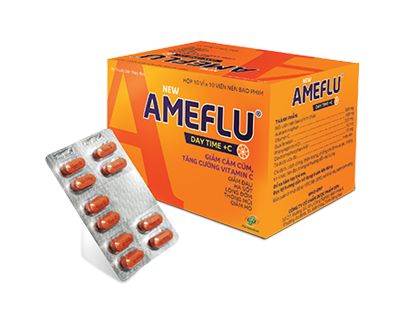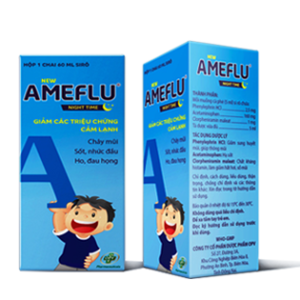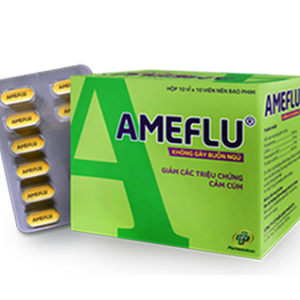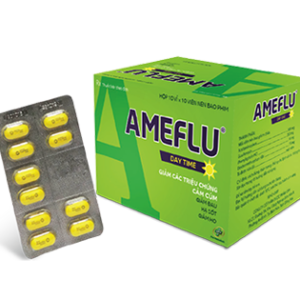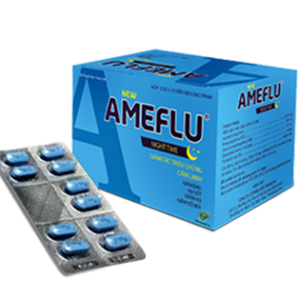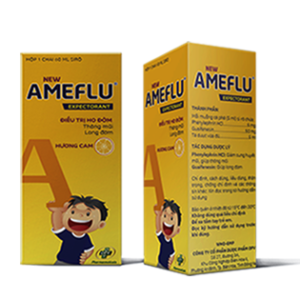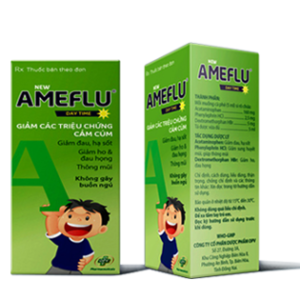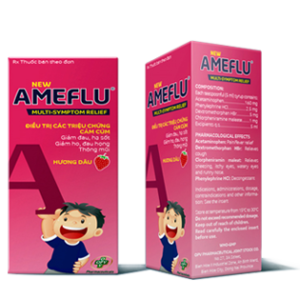COMPOSITION: Each film coated caplet contains:
Active ingredients:
Acetaminophen….………………..500 mg
Guaifenesin………………………..200 mg
Phenylephrine HCl………………..10 mg
Dextromethorphan HBr…………..15 mg
Vitamin C……………………… ..100 mg
Excipients: Maize starch, pregelatinized starch, povidone K30, sodium starch glycolate, talc, magnesium stearate, colloidal silicon dioxide (aerosil 200), anhydrous citric acid, sunset yellow lake, opadry orange AMB.
INDICATIONS:
It is indicated to relieve the symptoms of flu and common cold:
– Fever
– Aches and pains
– Headache
– Cough
– Sore throat
– Nasal congestion (stuffy), runny nose.
– Helps loosen phlegm (mucus) and thin bronchial secretions to make coughs more productive.
DOSAGE AND ADMINISTRATION:
– Adults and children from 12 years and older: Take 1 caplet every 6 hours. Do not take more than 6 caplets in 24 hours.
– Children (6-12 years): ½ caplet every 6 hours, not to exceed 3 caplets in 24 hours.
CONTRAINDICATIONS:
– Patients with known hypersensitivity to any ingredients of this product.
– Patients who are receiving MAOIs (see Drug interaction section).
– Patients with coronary disease and severe hypertension.
– G6DP insufficiency.
– Patients with severe hepatic failure, nephrolithiasis, hyperoxaluria and disorders of oxalate metabolism.
– Children under 6 years.
Special precaution and warning when using medication containing Acetaminophen:
- The doctor must warn the patients about the symptoms of serious skin reactions including: Stevens-Johnson Syndrome (SJS), toxic epidermal necrolysis (TEN), or Lyell Syndrome, acute generalized exanthematous pustulosis (AGEP).
WARNINGS AND PRECAUTIONS:
- Can cause rare but serious skin reactions, can cause death including Stevens-Johnson Syndrome (SJS), toxic epidermal necrolysis (TEN), or Lyell Syndrome, acute generalized exanthematous pustulosis (AGEP).
- Description of above syndromes:
+ Steven-Johnson syndrome (SJS): drug allergies can be bullous, bullae localize around the natural cavities: the face, nose, mouth, ears, genitals and anus. Also may include high fever, pneumonia, liver, kidney dysfunction. Diagnosis of Steven-Johnson syndrome (SJS) when at least two natural cavities injured.
+ Toxic epidermal necrolysis (TEN) is the most severe allergic reactions can include:
– The diversity in skin lesions: morbilliform erythema, scarlatinoid erythema, erythema or bullous erythema, the lesions rapidly spread throughout the body;
– Ophthalmic mucosa lesions: corneal inflammation, purulent conjunctivitis, corneal ulcer.
– Injury to gastrointestinal mucosa: stomatitis, erosive oral mucosa, ulceration of pharynx, throat, esophagus, stomach, intestines;
– Injury to the genital, urinary mucosa.
– There are also the serious systemic symptoms such as fever, gastrointestinal bleeding, pneumonia, glomerulonephritis, hepatitis,… high mortality rate: 15-30%.
+ Acute generalized exanthematous pustulosis (AGEP): small, sterile pustules, arising within large areas of erythema. Lesions usually appear in the folds like the underarms, groin and face, then can spread throughout the body. Usual systemic symptoms of fever, neutrophilia in blood test
- When detecting first signs of skin rash or any other hypersensitivity reaction, patients should stop using the drug. Patients with history of severe skin reaction caused by acetaminophen, do not take again, inform the medical staff when having medical care.
Do not use with any other product containing Acetaminophen.
Ask a doctor before use if you have:
Heart disease, liver disease, diabetes, hyperthyroidism. Cough that occurs with too much phlegm (mucus), high blood pressure, renal failure, glaucoma, hyperoxaluria, trouble urinating due to enlarged prostate gland. Chronic cough that lasts as occurs with smoking, asthma, chronic bronchitis or emphysema.
Stop use and ask a doctor if:
– New symptoms occur.
– Redness or swelling is present.
– Pain, nasal congestion, or cough gets worse or lasts more than 7 days.
– Fever gets worse or lasts for more than 3 days.
– You get nervous, dizzy or sleepless.
– Cough comes back or occurs with fever, rash or headache that lasts.
These could be signs of a serious condition.
– Vitamin C – Related: Do not take high dose of vitamin C which exceeds 1g/24 hours. Due to a mild stimulant effect, it is preferable not to take the drug at the end of the day.
Use in pregnancy and breast-feeding: Ask a doctor before use
Effects on ability to drive and operate machine: Cautiously use when driving vehicle or operating machinery.
SIDE EFFECTS:
There are rare cases of allergy such as: Skin rash, erythema, urticaria. Other side effects are restlessness, insomnia, hypertension, hyperoxaluria, arrhythmia, heart failure, thrombocytopenia, haemolytic anaemia, hepatic failure, dizziness, headache, nausea, vomiting, gastric irritation, tremor, weakness, hallucinations and difficulty breathing.
In case of an unexpected reaction, consult your physician.
INTERACTIONS:
- Do not take this product if you are now taking a prescription of monoamine oxidase inhibitor (MAOI) (certain drugs for depression, psychiatric or emotional conditions, or parkinson’s disease), or for 2 weeks after stopping the MAOI drug. If you do not know if your prescription drug contains an MAOI, ask a doctor or pharmacist before taking this product.
- Phenytoin, barbiturate, carbamazepin, isoniazid may increase the hepatotoxicity of Acetaminophen.
- Concomitant use of phenylephrine with other sympathomimetic amines can increase the risk of cardiovascular side effects.
- Phenylephrine may reduce the efficacy of beta-blocking drugs and antihypertensive drugs (including debrisoquine, guanethidine, reserpine, methyldopa). The risk of hypertension and other cardiovascular side effects may be increased.
- Tricyclic antidepressants (e.g. amitriptyline, imipramine): May increase the risk of cardiovascular side effects with phenylephrine.
- Concomitant use of phenylephrine with ergot alkaloids (ergotamine and methylsergide): Increase the risk of ergotism.
- Concomitant use of phenylephrine with digoxin: Increase the risk of irregular heartbeat or heart attack.
- Concomitant use of phenylephrine with atropine will block the reflex bradycardia that phenylephrine causes.
- Concomitant use of dextromethorphan and CNS inhibitors may increase the CNS inhibition of these drugs.
- Quinidine inhibits cytochrome P450 2D6 and markedly increases the plasma levels of dextromethorphan which causes increased side effects of dextromethorphan.
- Concurrent administration of more than 200 mg of vitamin C and 30 mg of elemental iron increases the absorption of iron from the GI tract.
- Increased urinary excretion of vitamin C and decreased excretion of aspirin occur when the drugs are administered concurrently.
- Concurrent administration of vitamin C and fluphenazine may result in decreased plasma concentration of fluphenazine.
Large dose of vitamin C may destroy vitamin B12.
OVERDOSAGE AND TREATMENT:
Acetaminophen:
Symptoms: Nausea, vomiting and abdominal pain (normally settle within 24 hours of ingestion). After 24 hours symptoms may include right subcostal pain and tenderness, usually indicates development of hepatic necrosis. Liver damage is greatest 3-4 days after ingestion and may lead to encephalopathy, haemorrhage, hypoglycaemia, cerebral oedema and death.
Treatment: Treatment is based on plasma concentration. Acetylcysteine protects the liver if administered within 24 hr after ingestion (most effective if given within 8 hours). Dose: 140 mg/kg orally (loading) followed by 70 mg/kg every 4 hours for 17 doses. Activated charcoal or gastric lavage may be treated to decrease absorption of Acetaminophen.
Phenylephrine hydrochloride:
Symptoms: Hypertension, headache, convulsions, cerebral haemorrhage, palpitation, slow heart rate.
Treatment: Should provide symptomatic and supportive care.
Dextromethorphan:
Symptoms: Nausea, vomiting, somnolence, blurred vision, nystagmus, urinary retention, euphoria, hallucination, ataxia, respiratory failure and convulsion.
Treatment: Symptomatic and supportive treatment, can administer intravenous injection of naloxon 2 mg, to be repeat if necessary.
Vitamin C:
Symptoms: Nephrolithiasis, nausea, gastritis and diarrhea.
Treatment: Forced diuresis by infusion may be effective after taking large doses.
An overdose of Guaifenesin is not likely to cause life-threatening symptoms.
In case of accidental overdose, contact a doctor or come to the nearest hospital immediately.
PRESENTATION:
10 caplets packed in blister.
Box of 1 blister, 10 blisters or 20 blisters
STORAGE: Store in temperature from 150C to 300C, in a dry place and protected from light.
SHELF-LIFE: 36 months from manufacturing date. Do not use after expiry date.
DATE OF REVISION OF PACKAGE INSERT:
KEEP OUT OF REACH OF CHILDREN
READ THE ENCLOSED INSERT CAREFULLY BEFORE USE
DO NOT EXCEED RECOMMENDED DOSAGE
FOR FURTHER INFORMATION, CONSULT YOUR PHYSICIAN
Manufactured with technology from:
Ameripharm – USA
Manufacturer:
OPV PHARMACEUTICAL JOINT STOCK COMPANY
Lot 27, Road 3A, Bien Hoa Industrial Zone II, Dong Nai Province.
Tel : (061) 3992999 Fax: (061) 3835088




